Representing context and priority in working memory

Representing context and priority in working memory
Wan, Q.; Ardalan, A.; Fulvio, J.; Postle, B. R.
AbstractThe ability to prioritize among contents in working memory (WM) is critical for successful control of thought and behavior. Recent work has demonstrated that prioritization in WM can be implemented by representing different states of priority in different representational formats. Here, we explored the mechanisms underlying WM prioritization by simulating the double serial retrocuing (DSR) task with recurrent neural networks (RNNs). Visualization of stimulus representational dynamics using principal component analysis (PCA) revealed that the network represented trial context (order of presentation) and priority via different mechanisms. Ordinal context, a stable property lasting the duration of the trial, was accomplished by segregating representations into orthogonal subspaces. Priority, which changed multiple times during a trial, was accomplished by separating representations into different manifolds within each subspace. We assessed the generality of these mechanism by applying dimensionality reduction and multiclass decoding to fMRI and EEG datasets and found that priority and context are represented differently along the dorsal visual stream, and that behavioral performance is sensitive to trial-by-trial efficacy of priority coding, but not context coding.